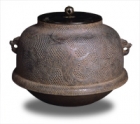Japanese Gallery (Honkan) Room 14
September 5, 2006 (Tue) - October 29, 2006 (Sun)
The kettle is a prominent element of the tea ceremony. The phrase "put a kettle over the fireplace" is often used to refer to having a tea ceremony. "A single tea kettle may well determine the grade of a tea ceremony," said Ii Naosuke, the shogun's Prime Minister (1858-1860) and renowned tea master.
Ashiya in Chikuzen province (present Fukuoka prefecture) and Tenmyo in Shimotsuke province (present Tochigi prefecture) are two places famous for tea kettle production since long ago. Characterized by the neat shape known as shinnari and smooth, glossy texture of the iron surface, Ashiya ware were loved by Buddhist priests, aristocrats and warriors during the Nanbokucho (1333-1392) and the Muromachi periods (1392-1573). In contrast to Ashiya, Tenmyo ware have more unique shapes and rough surfaces known as "ragged skin" or "rock skin". Tea ceremony records such as "Tennojiyakaiki" (1548-1590) and "Matsuyakaiki" (1533-1650) often refer to various types of kettles thought to be Tenmyo ware, indicating that preferences changed in accordance with the tea ceremony 's shift from the lavish shoin style, which featured gorgeous imported items, to the subdued wabi style.
Works by the casters at Sanjokamaza in Kyoto appeared in the Momoyama period. These Kyoto ware designs were characterized by innovative shapes and decoration made for tea masters or in their favorite styles such as Rikyu's Amidado style, Unryu style and Shirihari style.
This display is organized with representative works from the Ashiya ware to Edo period kettles that distinctly show the characteristics of their provenances and schools. We hope visitors will enjoy the shapes, surface textures and designs of tea kettles, which demonstrate how the tea masters sought beauty in iron.

